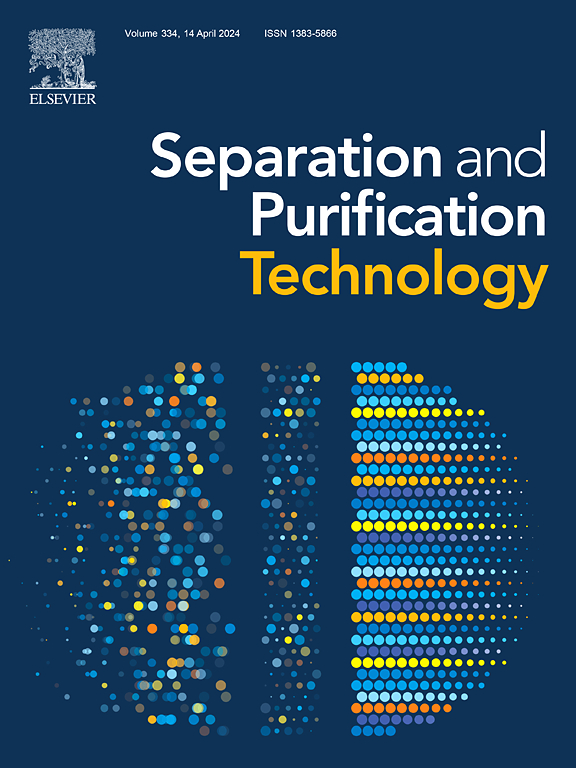An anion-functionalized MOF based on electrostatic potential matching strategy for efficient capture of CO2 from high temperature and humid flue gas
IF 8.1
1区 工程技术
Q1 ENGINEERING, CHEMICAL
引用次数: 0
Abstract
Efficient capture of CO2 from flue gas will bring significant environmental and economic benefits. But the process is full of challenge because high temperature and humid flue gas always damages the adsorbent. In the present work, a stable anion-pillared MOF (named HBU-24) was obtained by the assembly of ligand L (L = 1,1,2,2-tetra(pyridin-4-yl)ethene), Cd2+ and TiF62− ions. The BET surface area of HBU-24 achieves 769.9 m2/g and two kind of pore sizes are found (5.2 Å and 8.6 Å). Due to the matching of the electrostatic potential of fluorine atoms of TiF62− with that of carbon atoms of CO2, the adsorption capacity of CO2 is as high as 80.2 cm3/g at ambient condition, but the uptakes of CH4 and N2 are relatively low (16.0 cm3/g and 3.0 cm3/g). The IAST selectivity of CO2/N2 (v/v: 15/85) and CO2/CH4 (v/v: 50/50) was calculated as 1662.2 and 63.3. More importantly, it can also efficiently capture CO2 even at 323 K (59.8 cm3/g). The adsorption mechanism was elucidated through GCMC and DFT calculations. Furthermore, dynamic breakthrough experiments were carried out under different temperature and humidity conditions, the penetration time of CO2 was longer than that of N2, which further proved that HBU-24 was suitable to capture CO2 from high temperature and humid flue gas.


基于静电电位匹配策略的阴离子功能化MOF高效捕获高温潮湿烟气中的CO2
有效地从烟气中捕集二氧化碳将带来显著的环境和经济效益。但高温高湿烟气对吸附剂的破坏是该工艺的一大挑战。在本工作中,通过配体L (L = 1,1,2,2-四(吡啶-4-基)乙烯)、Cd2+和TiF62−离子的组装得到了一个稳定的阴离子支柱MOF(命名为HBU-24)。HBU-24的BET比表面积达到769.9 m2/g,有两种孔径(5.2 Å和8.6 Å)。由于TiF62−的氟原子静电电位与CO2的碳原子静电电位相匹配,在环境条件下对CO2的吸附量高达80.2 cm3/g,而对CH4和N2的吸附量相对较低(分别为16.0 cm3/g和3.0 cm3/g)。CO2/N2 (v/v: 15/85)和CO2/CH4 (v/v: 50/50)的IAST选择性分别为1662.2和63.3。更重要的是,即使在323 K(59.8 cm3/g)的温度下,它也能有效地捕获二氧化碳。通过GCMC和DFT计算阐明了吸附机理。此外,在不同温度和湿度条件下进行了动态突破实验,CO2的渗透时间比N2的渗透时间长,进一步证明了HBU-24适用于捕获高温高湿烟气中的CO2。
本文章由计算机程序翻译,如有差异,请以英文原文为准。
求助全文
约1分钟内获得全文
求助全文
来源期刊

Separation and Purification Technology
工程技术-工程:化工
CiteScore
14.00
自引率
12.80%
发文量
2347
审稿时长
43 days
期刊介绍:
Separation and Purification Technology is a premier journal committed to sharing innovative methods for separation and purification in chemical and environmental engineering, encompassing both homogeneous solutions and heterogeneous mixtures. Our scope includes the separation and/or purification of liquids, vapors, and gases, as well as carbon capture and separation techniques. However, it's important to note that methods solely intended for analytical purposes are not within the scope of the journal. Additionally, disciplines such as soil science, polymer science, and metallurgy fall outside the purview of Separation and Purification Technology. Join us in advancing the field of separation and purification methods for sustainable solutions in chemical and environmental engineering.
 求助内容:
求助内容: 应助结果提醒方式:
应助结果提醒方式:


